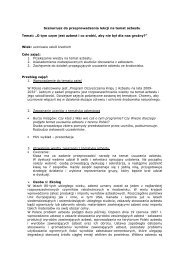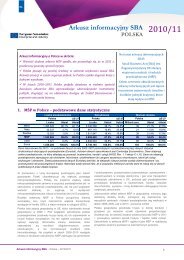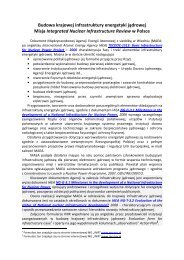Zielona księga w sprawie partnerstw publiczno-prywatnych i prawa ...
Zielona księga w sprawie partnerstw publiczno-prywatnych i prawa ...
Zielona księga w sprawie partnerstw publiczno-prywatnych i prawa ...
You also want an ePaper? Increase the reach of your titles
YUMPU automatically turns print PDFs into web optimized ePapers that Google loves.
4. The public authorities of Member States often have recourse to PPP arrangements to<br />
undertake infrastructure projects, in particular in sectors such as transport, public health,<br />
education and national security. At European level, it was recognised that recourse to<br />
PPPs could help to put in place trans-European transport networks, which had fallen very<br />
much behind schedule, mainly owing to a lack of funding 1 . As part of the Initiative for<br />
Growth, the Council has approved a series of measures designed to increase investment<br />
in the infrastructure of the trans-European transport network and also in the fields of<br />
innovation, research and development, mainly through forms of PPPs 2 .<br />
5. However, while it is true that cooperation between the public and private sectors<br />
can offer micro-economic benefits permitting execution of a project that provides<br />
value for money and meets public interest objectives, recourse to PPPs cannot be<br />
presented as a miracle solution for a public sector facing budget constraints 3 .<br />
Experience shows that, for each project, it is necessary to assess whether the<br />
partnership option offers real value added compared with other options, such as<br />
the conclusion of a more traditional contract 4 .<br />
6. The Commission also notes with interest that some Member States and<br />
accession countries have created tools to coordinate and promote PPPs, aimed,<br />
inter alia, at disseminating „good practice” for PPPs at national or at European<br />
level. The se tools aim to make related expertise mutually available (for example<br />
the Tasks forces in the United Kingdom or in Italy) and thus advise users about the<br />
different forms of PPP and their stages, such as initial conception, how to choose a<br />
private partner, the best allocation of risks, the choice of contractual clauses or<br />
even the integration of community financing.<br />
7. Public authorities have also set up partnership structures with the private sector<br />
to administer public services, particularly at local level. Public services concerned<br />
with waste management or water or energy distribution are thus increasingly being<br />
entrusted to businesses, which can be public, private, or a combination there of.<br />
The Green Paper on services of general interest points out in this context that<br />
when a public authority decides to award the management of a service to a third<br />
party, it is bound to comply with the rules on public contracts and concessions,<br />
even if this service is deemed to be of general interest 5 . The European Parliament<br />
1 See Communication from the Commission of 23 April 2003 „Developing the trans-European transport<br />
network: innovative funding solutions – interoperability of electronic toll collection systems”, COM (2003)<br />
132, and the report of the high-level group on the trans-European transport network of 27 June 2003.<br />
2 Conclusions of the Presidency, Brussels European Council, 12 December 2003.<br />
3 Eurostat, the Statistical office of the European Communities, has on the llth of February 2004<br />
(cf.press release STAT/04/18) taken a decision on the accounting treatment in national<br />
accounts of contracts undertaken by government units in the framework of partnerships with nongovernment<br />
units. The decision specifies the impact on government deficit/surplus and debt. Eurostat<br />
recommends that the assets involved in a public-private partnership should be classified as nongovernment<br />
assets, and there fore recorded off balance sheet for government, if both of the<br />
following conditions arę met: l. The private partner bears the construction risk, and 2. The<br />
private partner bears at least one of either availability or demand risk.<br />
4 See Communication from the Commission to the Council and to the Parliament “Public finances in<br />
EMU 2003”, published in the European Economy No 3/2003 (COM (2003) 283 final).<br />
5 COM (2003)270 final. See, for the text of the Green Paper and the contributions,<br />
http://europa.eu.int/comm.secretariat_general/services_general_interest.<br />
38

















